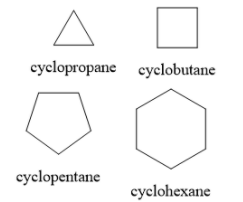
According to Baeyer’s strain theory, which of the following are the most stable cyclic compounds?
A ) Cyclopropane
B ) Cyclobutane
C ) Cyclopentane
D ) Cyclohexane
Answer
414.4k+ views
Hint: According to Baeyer's strain theory, the stability of cycloalkanes is dependent on the variation between the bond angles present in the ring system and the normal tetrahedral bond angle. Greater is this difference, greater is the strain on the ring system and lesser is the stability of the ring. To find out the most stable cyclic compound, determine the angle strain for each cycloalkane.
Complete answer:
Baeyer’s strain theory was proposed by the German chemist Dr. Bayer for the determination of stability order in rings.
The angle strain is the magnitude of the difference between the desired carbon-carbon bond angle and the actual carbon-carbon bond angle. Closer is the actual carbon-carbon bond angle to the desired carbon-carbon bond angle, lower is the angle strain and greater is the stability of cycloalkane.
Cycloalkanes are hydrocarbons containing carbon and hydrogen atoms. They contain all single bonds. They contain one (or more) ring of carbon atoms. Cyclopropane, cyclobutane, cyclopentane and cyclohexane contain 3,4,5, and 6 carbon atoms respectively. The structures of cycloalkanes are shown below:

The decreasing order of the stabilities of cycloalkanes is cyclopentane > cyclohexane > cyclobutane > cyclopropane.
For cyclopentane, the angle strain is lowest. Hence, among the given cycloalkanes, cyclopentane is the most stable cycloalkane.
Hence, the option C ) cyclopentane is the correct option.
Note: Greater is the difference between the desired carbon-carbon bond angle and the actual carbon-carbon bond angle, greater is the angle strain and lower is the stability of the cycloalkane.
Complete answer:
Baeyer’s strain theory was proposed by the German chemist Dr. Bayer for the determination of stability order in rings.
The angle strain is the magnitude of the difference between the desired carbon-carbon bond angle and the actual carbon-carbon bond angle. Closer is the actual carbon-carbon bond angle to the desired carbon-carbon bond angle, lower is the angle strain and greater is the stability of cycloalkane.
Cycloalkanes are hydrocarbons containing carbon and hydrogen atoms. They contain all single bonds. They contain one (or more) ring of carbon atoms. Cyclopropane, cyclobutane, cyclopentane and cyclohexane contain 3,4,5, and 6 carbon atoms respectively. The structures of cycloalkanes are shown below:

| Cycloalkane | Desired carbon-carbon bond angle | actual carbon-carbon bond angle | Angle strain |
| Cyclopropane | \[109^\circ \] | \[ 60 ^\circ \] | \[ 49 ^\circ \] |
| Cyclobutane | \[109^\circ \] | \[ 90^\circ \] | \[ 19 ^\circ \] |
| Cyclopentane | \[109^\circ \] | \[ 108^\circ \] | \[ 1 ^\circ \] |
| Cyclohexane | \[109^\circ \] | \[ 120^\circ \] | \[ 11 ^\circ \] |
The decreasing order of the stabilities of cycloalkanes is cyclopentane > cyclohexane > cyclobutane > cyclopropane.
For cyclopentane, the angle strain is lowest. Hence, among the given cycloalkanes, cyclopentane is the most stable cycloalkane.
Hence, the option C ) cyclopentane is the correct option.
Note: Greater is the difference between the desired carbon-carbon bond angle and the actual carbon-carbon bond angle, greater is the angle strain and lower is the stability of the cycloalkane.
Recently Updated Pages
Master Class 11 Economics: Engaging Questions & Answers for Success

Master Class 11 Business Studies: Engaging Questions & Answers for Success

Master Class 11 Accountancy: Engaging Questions & Answers for Success

The correct geometry and hybridization for XeF4 are class 11 chemistry CBSE

Water softening by Clarks process uses ACalcium bicarbonate class 11 chemistry CBSE

With reference to graphite and diamond which of the class 11 chemistry CBSE

Trending doubts
What are the elders in Goa nostalgic about class 11 social science CBSE

Define least count of vernier callipers How do you class 11 physics CBSE

Write the differences between monocot plants and dicot class 11 biology CBSE

Which of the following is not a feature of the election class 11 social science CBSE

The mass of oxalic acid crystals H2C2O42H2O required class 11 chemistry CBSE

How many squares are there in a chess board A 1296 class 11 maths CBSE




